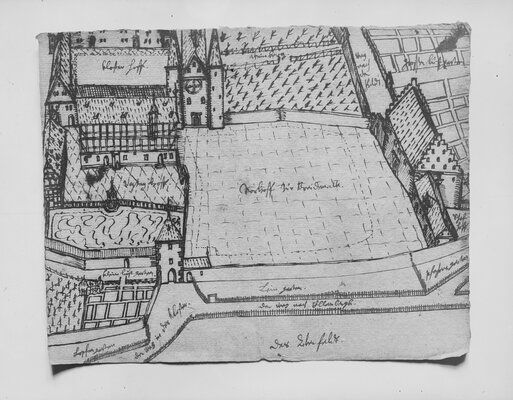From monastery to workhouse 1113–1874
![[Translate to englisch:] Karte des Amts Melsungen mit dem Bezirk Breitenau, Ausschnitt, Wilhelm Dillich (Bildarchiv Foto Marburg, fm1501478).](/user-daten/_processed_/9/8/csm_Karte-des-Amts-Melsungen-um-1615_klein__ee6fc52d51.jpg)
The formation and dissolution of the monastery
The Benedictine monastery of Breitenau was founded in 1113. Around 1250, the Romanesque pillar basilica consisting of three naves was completed. During the time of the monastery, a cloister could be found on the north side of the church; stables and barns were located on the west side of the site. The tithe barn, in which Breitenau Memorial has been located since 1984, dates to the 15th century. The Gothic-style reconstruction of the eastern part of the church took place shortly before the Reformation began. Shortly afterwards, the monastery was secularized in 1527 under Landgrave Philipp (1504–1567) and converted into an aristocratic estate. In 1579 the monastery church was converted into a horse stable and agricultural storage. This involved tearing down the lateral naves of the former basilica, walling up the archways and drawing several additional floors into the central nave. The 17th century then witnessed yet another transformation. Landgrave Moritz of Hesse-Kassel (1572–1632) expanded the secularized monastery into a country residence. Throughout the course of the Thirty Years' War, the monastery complex was severely damaged and became increasingly dilapidated during the following decades.

Breitenau institution for corrections and the rural poor (Correktions- und Landarmenanstalt Breitenau)
When the Breitenau institution for corrections was established in 1874, the history of the monastery had already dated back three centuries. The workhouse came into existence as a result of the annexation of Kurhessen by Prussia (1866) and the subsequent reorganization of the administration. In the year 1867, the district of Kassel was founded and a municipal constitution was introduced along with a municipal association as a body of self-government. As per Prussian decree, the return of the seized Hessian state treasure was subject to the condition that both a workhouse and an institution for the rural poor be maintained. When the association of municipal districts (Bezirkskommunalverband) acquired the former monastery in 1872, it agreed under contract to preserve monuments and ornaments and to move the Protestant church, which congregated in the tithe barn at the time, to the historic basilica. This marked the beginning of the dual use of the former monastery church: The one side of the church housed the workhouse inmates; the other side was where the Protestant parish held its services.
The facility kept persons for the sake of "corrective detention" (korrektionelle Nachhaft), such as beggars, vagabonds and "lewd women". Pursuant to Article 361 of the Reich criminal code (Reichsstrafgesetzbuch) of 1871, such individuals were considered criminal and thus sentenced to a short term in prison or a correctional house which was then followed by their placement in a workhouse. The idea was that they be re-educated here by means of compulsory work in the ways of an "orderly" life that reflected the bourgeois ideals of the time. In addition to the correctional facility, the district association (Bezirksverband) set up an institution for the rural poor on the site in 1877, in which welfare recipients were sometimes kept for decades on end, unlike the periods of sentencing typical for the correctional facility.
